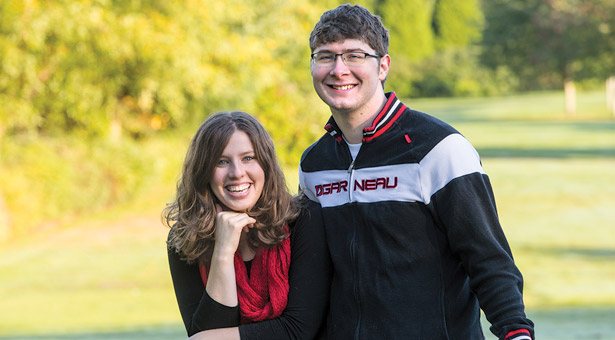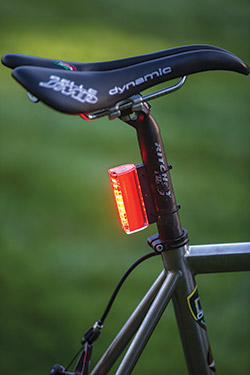Science & Technology Research and Discoveries
Illuminating Idea
Alumni Go the Extra Mile for Safer Cycling
By Clint Kelly (ckelly@spu.edu) | Photos by Mike Siegel
 Kayla Sanders Clyde ’11 and Peter Clyde ’13
worked together to create and market the
Orfos flare — “the world's safest taillight
for cyclists.”
Kayla Sanders Clyde ’11 and Peter Clyde ’13
worked together to create and market the
Orfos flare — “the world's safest taillight
for cyclists.”

Peter Clyde ’13 labored 60 to 70 hours a week, switching at 5 p.m. from his day job as an electrical engineer at Monsoon Solutions to work until midnight at home, inventing his revolutionary bike light. Day in, day out, six months from idea to proof of concept, three years from idea to market ready.
In 2014, the Kickstarter effort to raise working capital took 30 days of nonstop work — answering hundreds of emails, fielding a barrage of interview requests — but raised more than $157,000, nearly eight times the initial goal.
That money and time is what it took to create and bankroll the invention of “the world’s safest taillight for cyclists,” according to Outside magazine’s online edition.
Behold the Orfos Flare, the red light that casts 300 lumens — equal to the intensity and light dispersion of a modern car’s taillight. And that’s what it took for Peter and his customers to finally feel safe. Peter, whose three-hour round trip between Seattle and his day job in the Bellevue tech district in rain, fog, and snow had been harrowing at best, was now visible from all angles, including at night and in inclement weather.
Peter brainstormed the product name with his father, Rick Clyde ’76, a pastor who speaks Greek and Hebrew. With some admittedly “loose interpretation, they married transliterated words from those languages to come up with a new word — Orfos, “a light to become light.”
Peter’s wife, Kayla Sanders Clyde ’11, provided the business brain, emailing blogs, freelance writers, and news organizations to spark interest in the light. “That was pivotal to our success,” says Peter. “We are the perfect combination of different strengths.”
An Outside magazine journalist discovered the Orfos Flare online and contacted the Clydes, then discovered that his editor had already purchased one of the lights from Kickstarter. The resulting review called Peter’s light “eye-wateringly bright” and maybe “the last rear light you ever need.” From there, word of mouth reviews and availability on Amazon.com sped things along. Now, thousands of flares have sold, Peter says.
At $100 or more, the Orfos Flare might seem pricey. But owners report an unparalleled feeling of visibility and security at night and in bad weather.
“I love them (Orfos Flares) to bits! They attract attention, which is exactly what you want,” one customer commented on Amazon, while another remarked, “I set the red to blinking and the white to high beam, (and) I totally owned the darkness!”
“Seattle Pacific University taught me that faith and career were really meant to go hand in hand,” Peter says. “In the SPU engineering program, the focus is not only on the fundamentals of how to engineer something, but when beginning something new to always ask the question, ‘Should this be engineered?’”
The U.S. lags behind more cyclist-friendly countries like those of the United Kingdom in its cycling research, awareness, and safety, so Peter took cues from the U.S. auto industry. “There is a huge gap between car safety and cycling safety, and I work to bridge that gap,” he says. He hints that there are more products on his drawing board — “big things” that go beyond cycling.
